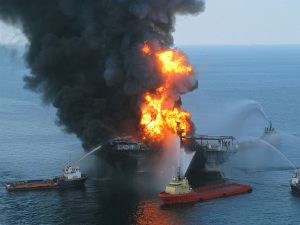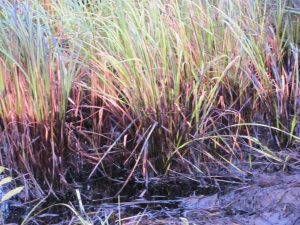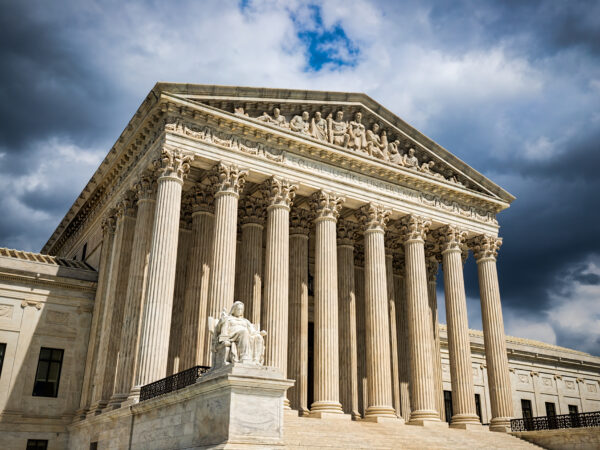
“It’s definitely a wicked problem” said co-organizer of the Crude Move Symposium, Katherine Bunting-Howarth, Associate Director of New York Sea Grant.
Experts from across the U.S and Canada came to Cleveland recently to lend their expertise and confront the inherent difficulty and danger of transporting oil by pipelines, ships, trains and trucks in case there’s a large oil spill in the Great Lakes Region and other critical Northern Watersheds.
A conference like this has never been held before.
Bunting-Howarth says, “We determined that with the increase in oil movement in 2014, we really needed to understand the pros and cons of the modes, and how the different modes of transport interact with each other.”
A surprising conclusion from many of the participants: transporting oil by pipeline might be one of the safest methods that exist right now.
Lessons learned from Deepwater Horizon

Platform supply vessels battle the blazing remnants of the off shore oil rig Deepwater Horizon, courtesy of US Coast Guard
One panel at the symposium in Cleveland concerned lessons learned from the Deepwater Horizon Oil Spill, the rig that exploded 50 miles off the shore of Louisiana in April of 2010, killing 11 workers and injuring many others. Oil flowed for 87 days before it was capped. 172 million gallons spilled. Coastal residents and clean-up workers were directly exposed to oil. The shoreline and wetlands were damaged. Fish and other wildlife and the seafood industry were harmed as well as the oil and gas industry.
It was the worst open water oil spill in U.S. history.
And it was the largest corporate settlement in U.S. history. BP agreed to pay $18.7 billion in fines.
A total of 1.84 million gallons of Corexit, a dispersant, was used to break up the oil that spilled in the ocean from the Deepwater Horizon accident, but the FDA says the dispersant had low potential to build up in seafood, was low in human toxicity, and there was little public health risk. However, 88,522 miles of the Gulf of Mexico were closed to fishing after the spill, and portions remained closed for almost a year.
In another panel, an expert on the Kalamazoo River Oil Spill in Marshall, Michigan, Homer Mandoka, Sgt. at Arms with the office of the Tribal Council and member of the Potawatomi Band, talked about his own personal experience.
He says he didn’t even know the Enbridge-owned pipeline existed in a tributary of the Kalamazoo River near where he lived until the morning of the oil spill in July of 2010.
He says the oil smell permeated the entire community, affected his breathing, and made his eyes burn.
About a million gallons of oil spilled into the creek and the Kalamazoo River. Thirty-five miles of the Kalamazoo River were closed for clean-up until June 2012.
In July 2016, Enbridge Inc. agreed to pay $177 million in penalties and improved safety measures in a settlement with the U.S. Justice Department and the Environmental Protection Agency.
In addition to the $1.2 billion spent on remedial efforts, Enbridge paid out $75 million dollars to help restore affected waterways and wetlands and provide additional public access points along the Kalamazoo river.
It was the worst inland oil spill in U.S. History.

Oil-stained grass in a wetland area of the Kalamazoo River after an oil pipeline burst, courtesy of USEPA
The Kalamazoo River oil spill was a flashpoint, said Mandoka and many other participants at the Crude Moves Oil Symposium in Cleveland.
That’s when many people became aware of the Enbridge-owned Line 5 pipeline which runs for 645 miles from Superior, Wisconsin to Sarnia, Ontario, carrying 540 thousand barrels of oil a day – mostly crude oil and natural gas liquids. That’s about 23 million gallons of oil a day.
Mandoka says one thing’s clear after the Kalamazoo oil spill: communities need to be told where those pipelines are placed, and emergency plans must be organized with local, state and federal agencies in the event of another spill like the one in Marshall, Michigan.
Mandoka and his tribe want Enbridge’s Line 5 pipeline decommissioned.
Enbridge spokesperson Ryan Duffy tells Great Lake Now the pipeline is all underground except for the 4.5 miles across the Straits and then “a short distance across the St. Clair river”
That 4. 5 miles under the Straits is what’s causing a lot of controversy and was the topic of many of the discussions at the Crude Move Symposium in Cleveland.
Critics of the pipeline made it clear they felt the pipeline was a threat to the Great Lakes, and said the portion where the pipeline sits on the sandy bottom under the Straits of Mackinac where the two opposing currents of Lake Huron and Lake Michigan meet is the worst place possible for an oil-carrying pipeline to be.
“Preparedness is a direction, not a place”
Doug Helton Regional Operations Supervisor with NOAA in Seattle has been responding to oil spills for three decades.
He says there are 8 to 10 thousand oil spills a year in the U.S. His office responds to about 100 to 200 spills a year.
Helton says, “The Great Lakes are different from ocean spills because it’s a drinking water resource for millions of people.”
However, Helton says, “Pipelines are generally safer than shipping by boat,”
He says, “Preparedness is a direction, not a place.” He says, “If you look at the history of oil spills, most have been marine spills.”
Helton says, “The risk here in the Great Lakes in the winter time is dealing with broken ice, or thin ice,” He says, “It’s not the dead of winter that’s the hardest problem. Dealing with broken ice is more difficult.”
“Once you spill oil, there is no good outcome”
Helton says, “Transporting oil is part of our economy. But once you spill oil, there is no good outcome.”
20 percent of U.S. oil refineries are in the Great Lakes Region. That’s why there’s so much oil going in and out of the area, and it’s also why the threat of oil spills is such a big concern.
The deadly tragedy in Quebec involving a train carrying crude oil was brought up several times throughout the conference.
In July 6, 2013, an unattended 74-car freight train carrying Bakken Formation crude oil rolled down a hill in Nantes and derailed in a downtown area, exploding into a fireball. 47 people were killed and half of the downtown area was destroyed. The incident pointed up the dangers of transporting oil by rail, and safety laws and regulations were strengthened as a result of the accident.
The incident caused many people both inside and outside the oil industry turn their gazes more favorably on pipelines.
BUT : what if an accident involving the Line 5 Pipeline in the Straits of Mackinac DID occur?
The U.S Coast Guard’s Management and Preparedness Advisor, Jerome Popiel, said his agency is charged with maintaining the safety of the waters. He said, “ We are the only federal agency singular organized around the Great Lakes Systems.” He said the overall objective of the Coast Guard in the event of an oil spill is to prevent an incident that would result in the loss of oil in the waters and a loss of lives. He said the Coast Guard is prepared, and has done emergency preparedness exercises with Enbridge, federal and local agencies in the Straits of Mackinac. But he said, “There’s no such thing a minor spill on the lakes where people get their drinking water.”
Why Pipelines?
Enbridge Energy’s Vice President of U.S. Operations Brad Shamla, who spoke on one of the panels, said his company, which owns the Line 5 pipeline under the Straits of Mackinac, “provides 70 percent of the oil refined in the Great Lakes Region. We’re talking about gasoline for vehicles, home heating – natural gas or propane – diesel for agriculture – and jet fuel for the Air Force.” He says people often don’t realize petroleum is needed to provide everything from infrastructure to manufacturing, and it’s even used to make cellphones.
He says the U.S. consumes 3. 4 billion barrels of gasoline a year – about 9 million barrels per day. And Enbridge uses 35 thousand miles of pipeline to get oil to people and companies who need it.
He says if Enbridge’s pipelines weren’t in operation, the 3 million barrels of oil Enbridge provides would have to be transported by trucks and rail. He said it would take 15 thousand trucks to move that amount of oil a day – or about 50 trains.
Shamla assured symposium attendees that for Enbridge, “safety is in everything we do.”
He described the recent hydrostatic testing underway to make sure the Enbridge’s pipelines can withstand high amounts of pressure. Enbridge spokesman Ryan Duffy tells Great Lakes Now those tests were successful.
So: How many spills have occurred along Line 5 since it was built in 1953? Duffy tells Great Lakes Now, “there have been just three releases along Line 5 in the last 15 years. There have been 29 releases in the more than 60 years of the Line, but a large percentage of those have been on Enbridge property at our facilities. Also, there has never been a release along the Straits section of Line 5.”
An autonomous underwater vehicle to inspect the Line 5 Pipeline
Enbridge’s Shamla says the Line 5 pipeline under the Straits of Mackinac is “very well designed – a seamless pipe.”
He says the company performs regular aerial patrols of the entire pipeline, and the control center automatically shuts down the pipeline the minute a pressure problem is detected.
He says the company is advancing several technologies to reduce the risk of a break in the pipeline, including a project in conjunction with Michigan Technological University to develop an autonomous underwater vehicle to inspect the pipeline on a regular basis. Shamla says “it’s our eyes on the pipe.” Shamla also says, “We’re also working on real-time monitoring by sponsoring a bouy out in the Straits to better understand the currents in the straits.” Shamla says Enbridge is also developing a system of mechanical anchors.
Co-organizer of the Crude Move Symposium Katherine Bunting-Howarth tells Great Lakes Now, “ I hope that participants left the Symposium with an appreciation of the complexity of crude oil (and other hazardous goods) transportation as well as a heightened awareness of the importance of spill prevention, preparedness and response. If people continue to use the multitude of products derived from crude oil on a daily basis, we need to increase our understanding of risk, hazards to people and the environment, economics, and the infrastructure networks of crude oil transportation to help decision-makers make the best possible choices.”
If people who care about the Great Lakes have been worried about whether someone is watching to make sure there’s a plan in place in the event of an oil spill in the largest source of freshwater in the world, this symposium should give them assurance. Experts are watching the lakes, watching oil-carrying trains, ships and pipelines, and making sure federal and local agencies are prepared in the event of an oil spill.
But whether environmental damage can be prevented if there IS a major oil spill in the Great Lakes: that’s another story.




